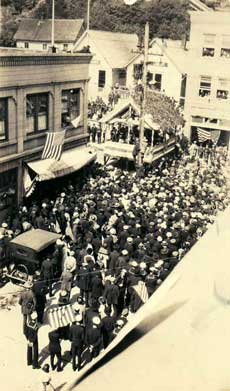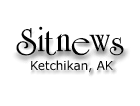 From Bookcase to Building(s) By June Allen January 01, 2004
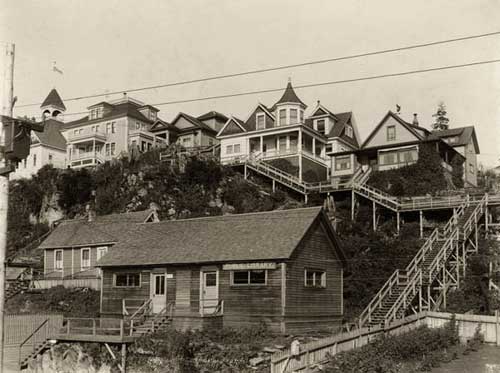 Photographer: Harriet Elizabeth Hunt; Donor: Ketchikan Public Library, Courtesy Tongass Historical Society 62.4.3.124 It was a cause the ladies took upon themselves right at the get-go in 1900. Their project almost immediately created a no-frills library, to borrow a modern term. Ketchikan's first library was a single bookcase! The ladies raised the money to have it built by a local craftsman and they donated the books and magazines from their own cherished collections. Their men were then recruited to haul the treasured and heavy bookcase from one merchant's business to another's, from church to schoolhouse, on a rotating basis - free of rent - so everyone could have the opportunity to read. For a few cents the readers could borrow a book or magazine. In a town that offered only dance halls, card rooms and saloons for entertainment, the little Ladies Library Club "library" was much welcomed. Libraries were much in the news across the nation in the final two decades or so of the 1800s. Immigrants in huge waves had entered the United States in the second half of the century and many of them learned to speak and read English in the wonderfully elegant Carnegie Libraries. Steel industrialist Andrew Carnegie, himself an immigrant from Scotland, used his incredible wealth to build many, many handsome and well stocked public libraries, some 1,700 of them in the United States alone, as well as in his native Scotland and elsewhere. To attract potential readers, some of the larger Carnegie libraries in the big cities were also equipped with gymnasiums, swimming pools and baths! Almost all had children's reading rooms. Small towns welcomed smaller libraries, many built to resemble little Greek temples. Reading was portrayed as a worthy objective, tasteful, refined and very American. To gain a Carnegie library, the host city or town had only to provide the land and maintenance. A Carnegie library was not available to Ketchikan. But, the women of the First City didn't let that stop them; they had formed their own Ladies Library Club with an eye to building the library's collections for the future. Only women could be members of the club, but men could be honorary members - depending on the level of their donation or participation, of course. Among the active founders of the club was Harriet Hunt, with the support of her devoted friend, Marie Heckman, the wife of J.R. Heckman, early cannery man, merchant and inventor of the floating fish trap. 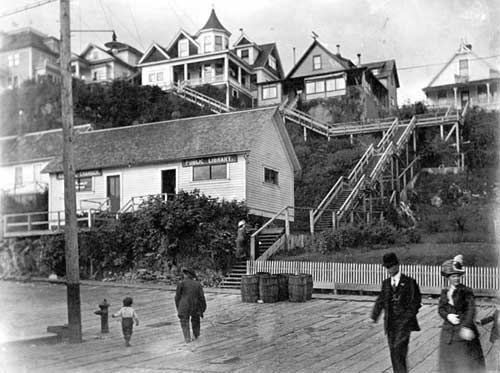 Photographer: Harriet Hunt; Donor: Forest J. Hunt, Courtesy Tongass Historical Society 62.4.3.171
Library club members paid dues of 25 cents a month and charged patrons a small fee for borrowing the books in their collection. With the income they bought more books and subscribed to additional magazines. By 1908, the city had continued to grow in spite of an economic slump in 1907 after the bottom fell out of the mining industry. The population was climbing toward 1,500, though, a considerable number in the fading years of the Alaska Gold Rush. The future appeared promising. In 1908 the ladies decided the time had come to deed the library lot and building to the City of Ketchikan. The city in return agreed to pay a librarian's daily salary of 25 cents ($4.80 today), in exchange for using the library for city council meetings. Once the city owned the lot, it turned the library building a half turn and added, right next door, and almost identical building of comparable measurements to be permanent city council chambers. In the previous eight years city council members had sometimes crowded into each other's businesses for meetings or occasionally adjourned to a saloon! Now, with the city's library and its own city council chambers in one location, the Dock and Main Streets intersection became the "heart" of the city. 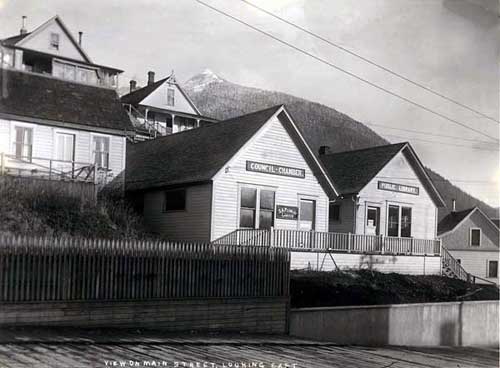 Photographer: Harriet Hunt; Donor: Forest J. Hunt, Courtesy Tongass Historical Society 62.4.3.47
The library club in 1908, however, was still responsible for upkeep of its little building. The structure needed a new floor or a suitable covering for the old one, specifics not mentioned in old records. The ladies apparently asked the city - dairyman Jacob Pittenger was the new mayor - for $25 for the job. But the city countered by saying it would rather find them "other suitable quarters." Harriet's husband Forest J. Hunt was no longer mayor, and, not trusting the city's definition of "suitable" quarters, Harriet Hunt and the other library club members
In time, additional bookcases were provided, all by local labor. Encyclopedias and reference books were added to the library's collection. Magazine subscriptions were increased. The library was growing to such an extent that new, printed membership cards ran out regularly! But by 1926 the ladies of the library were discovering that the town, population by now numbering close to 3,000, was perhaps getting too large for its little library structure and its mostly volunteer help. There were more hours for library patronage than there were for a librarian's presence. The big question in those years was, "Should the library be left open when a librarian is not in attendance?" There were other problems. Coal barges sometimes failed to arrive and left the library shivery cold. It was hard to find reliable help, and to keep things in repair. And then in 1932 the effects of the Great Depression hit Ketchikan, hard. By 1935 it was definitely time for change! In 1935 the Ladies Library Club was happy to turn the library over to the city. Books and library furniture were moved to the second floor of the KPU building on Front Street, now called City Hall. The library moved into the rooms now occupied by the council chambers and its adjacent meeting room. In the sturdy, concrete building the library had found a quiet, secure and comfortable home. And then in 1943 the city at last assumed financial responsibility for the entire library operation. There the library stayed until the mid-1960s when the new State of Alaska prepared to observe the 1967 Centennial of the Purchase of Alaska from Russia. This was to be a momentous, statewide celebration financed by both federal and state funds. Each community was asked to select a project/s or events to mark the anniversary of the Alaska Purchase. Ketchikan's Centennial committee chose to build a library/museum complex on Barney Way. In addition to the library building, other Centennial projects included the carving by Haida carver Jones Yeltatzie of the huge king salmon now mounted across the creek by the library, the carving by a Tsimshian artist of a Chief Kyan replica pole that was mounted at the head of Main Street (also gone now), and a little log replica of Fort Tongass on the hill behind the library, actually at the top of Upland Way (also gone now). At the time of the Centennial planning, the Barney Way area was largely a warren of very old, mostly very small shacks and houses, including Chief Johnson's house and his totem pole. The houses were connected by a narrow footpath that wound down to the creek and dead-ended below Bawden Street. It was occupied largely by minorities. The state, however, was planning to build a low-income housing project on the West End called Alder Park (also now gone). The estimated 87 displaced Barney Way folks would have a place to go, it was agreed. The entire Barney Way acreage was razed, with only the Chief Johnson pole being saved. The new Centennial library/museum complex overlooking scenic Ketchikan Creek falls was opened in 1969 and already at opening was running out of space! The Tongass Historical Society - that would share library space - had been founded in 1961 and at the time of the Centennial planning its collections were minimal, housed in one tiny room at the City Hall. Planners were optimistic about the building's size but even so, space was limited. It wasn't long before the library began to feel crowded for space. The special museum exhibits like the Indian canoes had no hope of being displayed. 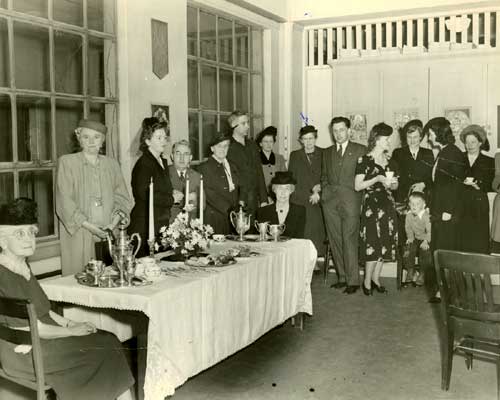 Donor: Bertha Hunt Wells, Courtesy Tongass Historical Society 70.3.6.15
Library founder Harriet Hunt is remembered today mostly for her marvelous photographs of early-day Ketchikan. This courageous wife and mother was bound by corsets and convention, and wore skirts that dragged in the mud and snagged on rough wooden boardwalks. She wore 'ladylike' shoes made more for the parlor than for the primitive boardwalks and hillsides of Ketchikan. Still, she took pictures from slippery docks and precarious perches and she climbed steep hillside paths to capture panoramic shots of Ketchikan and its environs. At first she had to pump water from the town tap and carry it home in buckets in order to develop her pictures on those heavy glass plates of the time. And she still found time to spearhead a library effort! Marie Heckman had it easier but she recognized the value of her friend Harriet's contributions to the town. In 1938, Mrs. Heckman, a wealthy woman in her own right, bequeathed $500 ($6,542.50 today) to the Ketchikan Library as a memorial to her dear friend, Harriet Hunt. Mrs. Hunt died in 1934, Mrs. Heckman in 1937. There is a plaque that hangs today on the library's wall with photos of both women. The inscription reads "In memory of Harriet Elizabeth Hunt, member of the original board of this library, and in grateful recognition of her zealous public spirit, this tablet and many books and furnishings of this room were the gifts of bequest of her friend and honor fellow citizen, Marie Capp Heckman." The money was used for tables, child-size chairs, a world globe and many, many new children's books. Women had worked hard for the town's library as did the women of the Ketchikan chapter of Beta Sigma Phi sorority who spearheaded the formation of Ketchikan's historical society back in 1961. It just may be up to the women of Ketchikan to again provide the spark, energy and womanpower to solve the problems now faced by the cramped library and museum. Go, ladies, and thanks for the history!
june@sitnews.org
All rights reserved. Not to be reprinted in any form without the written permission of June Allen.
|
||||||||
